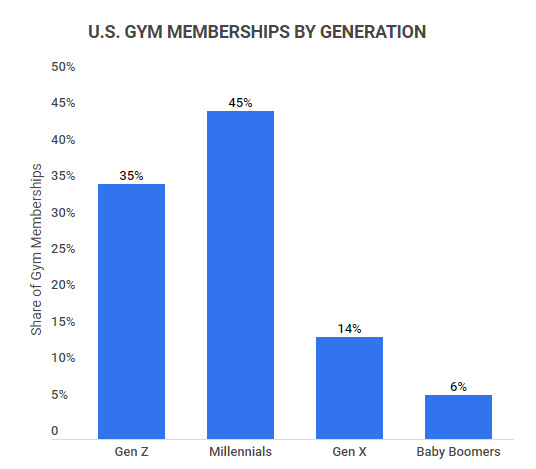- Industry Statistics
- Wedding Industry Statistics
- Yoga Industry Statistics
- Music Industry Statistics
- Landscaping Industry Statistics
- Bicycle Industry Statistics
- Coffee Industry Statistics
- Car Rental Industry Statistics
- Home Improvement Industry Statistics
- Insurance Industry Statistics
- Supplements Industry Statistics
- Golf Industry Statistics
- Fitness Industry Statistics
- US Media And Entertainment Industry Statistics
- Firearm Industry Statistics
- Financial Services Industry Statistics
- Health And Wellness Industry Statistics
- Trucking Industry Statistics
- Wine Industry Statistics
- Pet Industry Statistics
- Mobile App Industry Statistics
- Digital Marketing Industry Statistics
- Hotel Industry Statistics
- Retail Statistics
- Robotics Industry Statistics
- Jewelry Industry Statistics
- Appointment Scheduling statistics
- Restaurant Industry Statistics
- Food Delivery Statistics
- Food Truck Industry
- Fashion Industry
- Real Estate Industry
- US Film Industry
- US Beverage Industry
- USu202fFast Food Restaurants
- US Construction Industry
- US Book Industry
- Cosmetics Industry
- US Food Retail Industry
- US Pharmaceutical Industry
- US Healthcare Industry
- Airline Industry
- Automobile Industry
- Transportation Industry Statistics
- Event Industry Statistics
- Project Management Statistics
- Oil And Gas Industry Statistics
- Nursing Home Statistics
- Nursing Shortage Statistics
- Nursing Statistics
Fitness industry research summary. The fitness industry has been booming in recent years, as more and more consumers are investing in their health. Here are the key fitness industry and gym statistics globally and in the U.S.:
-
The market value of the global fitness industry is over $87 billion
-
The US fitness industry revenue in 2021 was $33.25 billion
-
In the United States, 39% of Americans hold gym memberships
-
Between now and 2028, the fitness industry is expected to grow 171.75% to $434.74 billion
-
From now until 2028, the online fitness industry is expected to see a growth of 33.10% per year
For further analysis, we broke down the data in the following ways:
Gym Members and Fitness Consumers | Gym Member Demographics | Health and Fitness Clubs | Pandemic

Fitness industry trends and projections
The fitness industry has changed over time with consumer interests. From the increased popularity of Yoga, to people wanting gym memberships, fitness is more popular than ever before. To see where the industry might be heading, we’ve gathered the latest fitness industry trends and projections:
-
Fitness industries have been growing at a rate of 8.7% per year for the past few years.
Prices for gym memberships and exercise programs are not necessarily getting higher; rather, more and more people are choosing to prioritize their physical health.
So many people realize that the benefits of physical fitness go beyond the obvious of weight loss and more energy; it can improve mental health as well.
-
Between 2011-2019, the revenue for gyms and health centers in the United States consistently rose each year.
In 2020, revenue dropped drastically due to the pandemic, social distancing, and the rise in online fitness programs. We saw in 2021 that the revenue for gym memberships rebounded and was on the rise again.
-
The fitness industry revenue declined by 32.45% in 2020 but rebounded to 0.55% pre-pandemic levels at the end of 2021.
The health industry that was hit the hardest during 2020-2021 were gyms and health centers. Even at the end of 2021, they were still down 22.5% from their revenue levels in 2019.
However, the online fitness industry was up 66.32% by the end of 2021 when compared to their pre-pandemic levels.
-
By the end of 2028, the expected revenue for the fitness industry in the United States is expected to be $434.74 billion.
This projected trend shows annual growth of 33.10% from 2021-2028. By 2028, the fitness industry will have grown 171.75%. The fastest-growing segment in the fitness industry is the online/digital fitness industry. It is expected to grow 640.1% from 2021-2018.
-
By 2030, there are predictions that the fitness industry will have 230 million members.
Currently, the United States has the highest gym industry revenue in the world. If the US wants to retain its leadership in the fitness industry, it would need to increase by 15.6 million members by 2030, or 1.33 million new gym members each year.
-
The online and digital fitness industry is expected to grow at a CAGR of 33.5% from 2020-2027.
This noteworthy growth is due largely to the fact that many prefer virtual fitness solutions because of the convenience factor of being able to exercise from your own home.
Fitness industry statistics by gym members and fitness consumers
The fitness industry is driven by gym memberships, and there are millions of Americans who go to the gym on the regular. Don’t believe us? Here are some fascinating fitness industry statistics by gym members and fitness consumers:
-
There are 64.19 million Americans who are members of a gym or health club.
This equates to about 19% of the population in the US having a gym membership. About 49.9% of Americans go to the gym at least twice a week.
Total number of gym memberships each year
Year Total Number of Gym Memberships 2019 64.2M 2018 62.5M 2017 60.9M 2016 57.3M 2015 55.3M 2014 54.1M 2013 52.9M 2012 50.2M -
The average American spends less than $30 per month on a gym membership in the United States.
The price can vary depending on the location, types of equipment and classes, and the facility. Budget gyms can cost as low as $10 per month, whereas elite fitness clubs often go as much as $100 per month. Aside from the monthly fee, you can also expect to pay other fees, such as initiation fees and annual fees.
-
Boutique fitness studios account for 42% of all gym memberships.
A boutique fitness studio is a small gym that focuses on group classes and specializes in one or two fitness areas. These studios typically cost two-four times more than other health clubs. This area of the fitness industry is expected to continue rising and is projected to grow by nearly 17% by 2025.
Fitness industry statistics by gym member demographics
Fitness industry gym memberships are more popular with certain demographics over others. Luckily, we’ve analyzed who goes to the gym, and our research found that:
-
The generational breakdown of the average gym’s membership is as follows:
-
Gen Z (born 1994-2022): 35%
-
Millennials (born 1979-1993): 45%
-
Gen X (born 1964-1979): 14%
-
Baby Boomers ( born 1949-1963): 6%

-

Fitness industry statistics by health and fitness clubs
The fitness industry is home to many fitness clubs that offer services to their members. While these clubs were impacted by the COVID-19 pandemic, many have recovered in 2023.
-
There are 32,270 health and fitness clubs in the United States.
Due to the pandemic, the number of health and fitness clubs declined, and $29.2 billion was lost in revenue between March 2020 and June 2021.
-
There are over 200,000 health and fitness clubs worldwide.
The United States, Germany, and the United Kingdom hold the highest number of fitness club memberships.
-
The United States has the most gym members, the most amount of gyms, and creates the most revenue when compared to all other countries in the world.
The US has 64.19 million gym members – the next closest is Germany, at 11.66 members. The US is home to 41,190 gyms – next is Brazil, with 29,525 gyms. The US recorded revenue of $35.03 billion USD – with Germany next in line at $6.17 USD.
Number of health clubs by country
Country Total Number of Health Clubs United States 41,190 Brazil 29,525 Mexico 12,871 Germany 9,669 Argentina 7,910 Italy 7,760 United Kingdom 7,239 South Korea 6,590 Canada 6,587 Japan 4,950
Fitness industry statistics and the pandemic
The fitness industry was impacted greatly by the COVID-19 pandemic. Many clubs and gyms were forced to close, costing employers over 30% of their typical revenues. To see just how much the pandemic impacted the fitness industry, here are some essential statistics:
-
The fitness industry experienced a 32.45% decline in revenue between 2019 and 2020.
The industries that were hit the hardest during the pandemic were gyms, health clubs, and boutique fitness studios.
-
75% of active adults were using live streaming workouts, and 70% of active adults were using on-demand workouts, in 2020.
During the year 2020, on-demand workout video usage grew by 311%, and live streaming workout videos grew by 971%. Between the months of March 2020-August 2020, the minutes spent streaming health and fitness content increased by 1,300%.
-
Globally, the home fitness equipment market grew at a rate of 40.4% from 2019-2020.
This market went from $6.76 billion in 2019 to $9.49 billion in 2020. This market is expected to decline by 3.16% by 2023 due to gyms and fitness centers opening their doors again.
-
The global fitness industry revenue had rebounded to its pre-pandemic levels by the end of 2021.
In 2020, the revenue took a huge hit and fell by 32.45%, only reaching a revenue of $107.48 billion.
-
The online fitness industry was worth $6.04 billion in 2019.
Due to the pandemic, it has since grown by 77.33% and is the fastest-growing market in the fitness industry. There are so many available options for online fitness, including niche fitness classes and convenient on-demand videos, that regular gyms cant compete with.
Fitness industry statistics FAQ
-
How much is the U.S. fitness industry worth?
The U.S. fitness industry is worth $33.25 billion. It experienced a significant dip due to the pandemic, but we have since seen how adaptable this market is with the rise of online and virtual fitness options.
The United States is the world’s largest fitness market; it leads in both revenue and in the number of members (there are currently 64.19 million gym members).
-
Is the fitness industry growing?
Yes, the fitness industry is growing. The fitness industry experienced a growth of 3-4% per year over the past decade, and all estimations are pointing towards the same amount of growth in the future. The job outlook is a reliable indicator of growth in this industry. The number of trainers and fitness instructors is estimated to grow 13% by 2028.
-
Is the fitness industry profitable?
Yes, the fitness industry is very profitable. Globally, it is worth over $96.7 billion, and all trends point to consistent growth of 3-4% per year. Here are a few reasons why the fitness industry is a profitable place to invest:
-
New gyms and health clubs are popping up everywhere
-
More and more people are thinking more carefully about their health and fitness
-
Virtual fitness is making exercise possible for those who otherwise wouldn’t have time to get to a gym
-
Budget-friendly gyms are making exercise more accessible to a wider range of customers
-
-
Is the fitness industry competitive?
The fitness industry is extremely competitive right now. Large, all-inclusive clubs are competing against smaller boutique studios. Boutique studios currently take up 42% of all gym memberships. However, the most competition these clubs and studios have is from the online and digital fitness platforms.
That industry is experiencing the most growth at a rate of 33.10 per year, while the gym industry is only predicted to have a growth rate of 7.21% per year.
-
Is the online fitness industry saturated?
Yes, the online fitness industry is extremely saturated. Social media has made it incredibly easy for anyone to become a trainer or health coach. The extreme and sudden growth has garnered a lot of attention from companies trying to make a splash in the fitness industry. Despite the saturation, the online fitness industry is expected to continue rising.
-
Who are the main competitors in the health and fitness market in the U.S.?
The main competitors in the health and fitness market in the U.S. are Anytime Fitness, L.A. Fitness, and Planet Fitness. Anytime Fitness is the biggest for-profit chain with 2175 clubs in North America. L.A. Fitness is the most profitable fitness company and has been for six years in a row. Planet Fitness is at the top of the list for the best gym for your budget.
-
How has the pandemic changed the fitness industry?
The pandemic has changed the fitness industry forever. The pandemic caused many people to prioritize their health, and social distancing opened up the door for virtual fitness to grow tremendously. More fitness options are available than ever before, creating opportunities for everyone to include fitness in their life, regardless of their budget or circumstances.
Conclusion
The fitness industry has changed immensely over the last few years. People all throughout the world are prioritizing health and fitness more than ever before. The market size of the fitness industry has grown exponentially, and the number of gyms, health clubs, and online fitness options is on the rise.
The biggest change has been in the virtual and online fitness industry. People are flocking to the convenience of being able to exercise on-demand from their own homes. The ability to cater to specific demographics or interests has driven many to use online fitness as well.
Wearable technology was the number one trend for 2021, which is not surprising, seeing how one in five Americans uses a smartwatch or fitness tracker.
References
-
ClubIntel. “230 by 2030 Implications for the U.S. Market.” Accessed on November 17, 2022.
-
BlobeNewswire. “Compete: Global Virtual Fitness Market to Hit $59,650.3 Million By 2027.” Accessed on November 17, 2022.
-
IHRSA Media Center. “Sharing the benefits of physical activity.” Accessed on November 17, 2022.
-
Forbes. “The Six Reasons the Fitness Industry is Booming.” Accessed on November 17, 2022
-
FinancesOnline. “87 Gym Membership Statistics You Must Learn: 2023 Cost, Demographics, and Market Share.” Accessed on March 12, 2023.
-
LiveStrong.Com. “113 Gym Membership Statistics You Need to Know.” Accessed on March 12, 2023.
- Industry Statistics
- Wedding Industry Statistics
- Yoga Industry Statistics
- Music Industry Statistics
- Landscaping Industry Statistics
- Bicycle Industry Statistics
- Coffee Industry Statistics
- Car Rental Industry Statistics
- Home Improvement Industry Statistics
- Insurance Industry Statistics
- Supplements Industry Statistics
- Golf Industry Statistics
- Fitness Industry Statistics
- US Media And Entertainment Industry Statistics
- Firearm Industry Statistics
- Financial Services Industry Statistics
- Health And Wellness Industry Statistics
- Trucking Industry Statistics
- Wine Industry Statistics
- Pet Industry Statistics
- Mobile App Industry Statistics
- Digital Marketing Industry Statistics
- Hotel Industry Statistics
- Retail Statistics
- Robotics Industry Statistics
- Jewelry Industry Statistics
- Appointment Scheduling statistics
- Restaurant Industry Statistics
- Food Delivery Statistics
- Food Truck Industry
- Fashion Industry
- Real Estate Industry
- US Film Industry
- US Beverage Industry
- USu202fFast Food Restaurants
- US Construction Industry
- US Book Industry
- Cosmetics Industry
- US Food Retail Industry
- US Pharmaceutical Industry
- US Healthcare Industry
- Airline Industry
- Automobile Industry
- Transportation Industry Statistics
- Event Industry Statistics
- Project Management Statistics
- Oil And Gas Industry Statistics
- Nursing Home Statistics
- Nursing Shortage Statistics
- Nursing Statistics





